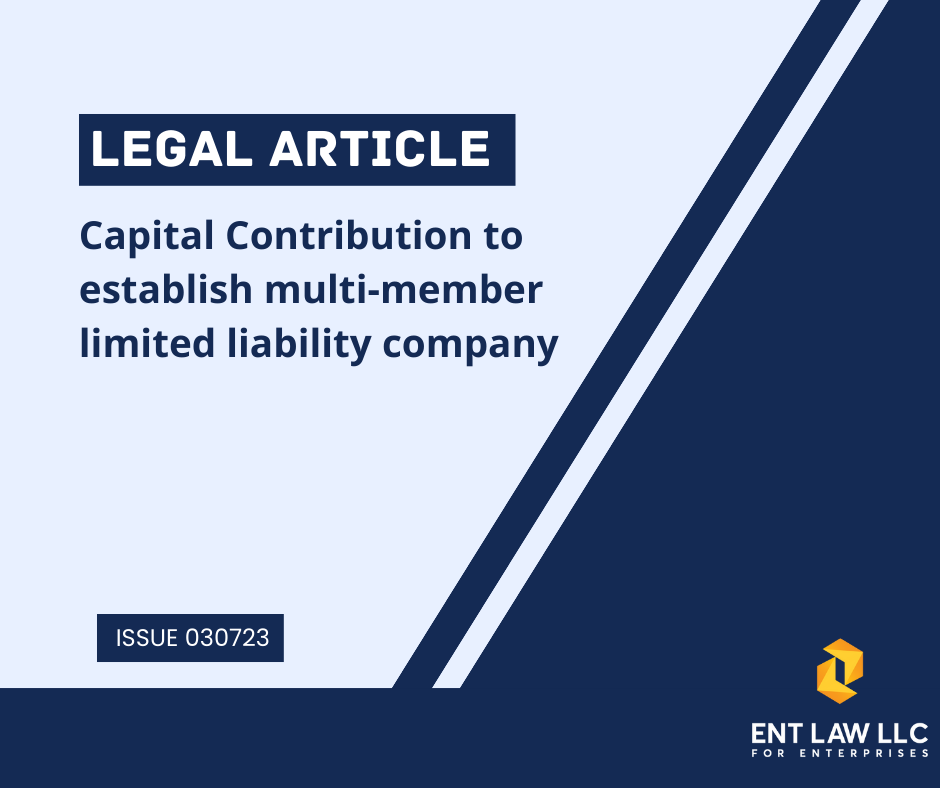Dear Valued Clients,
Contributed capital in companies in general and in multi-member limited companies in particular, is one of the most fundamental matter that needs to be carefully considered from the planning stage. To have the capital for their operation, especially after establishment, investors have to choose the amount of capital, type of capital contribution suitable with the scale, and business lines in compliance with the law.
In order to have a better understanding of the definition, types of capital contribution, term of contribution, and the responsibilities relating to the capital contribution of the members of a multi-member limited company in accordance with the law, Valued Clients can refer to our below legal article.
1. Definition of charter capital and capital contribution
According to clause 34, Article 4 of the Law on Enterprise 2020: “Charter capital is the total value of the assets that have been contributed or committed to contribute by members, or the owner of the company when establishing a limited company…”
In addition, pursuant to clause 27, Article 4 of the Law on Enterprise 2020: “Capital contribution is the total value of the assets a member has contributed or committed to contribute to a limited company,… The ratio of capital contribution is the ratio between the capital contribution of a member and the charter capital of a limited company“
Based on the foregoing regulations, it can be understood that charter capital is the total value of the capital contribution of company members and is recorded in the charter of such a company. And the capital contribution reflects the value of assets that a member contributed or owns in that company.
2. Types of assets contributed as capital and valuation of assets contributed as capital
In any case, assets contributed as capital must be assets under the legal ownership or legal use rights of the member. Types of assets that members of a multi-member limited company can use to contribute as capital includes:
(i) Vietnamese dong;
(ii) Convertible foreign currencies;
(iii) Gold;
(iv) Land use rights;
(v) Intellectual property rights, technologies, technical know-how;
(vi) Other assets that can be valued in Vietnamese dong.
In case the assets contributed as capital is not Vietnamese dong, convertible foreign currencies, or gold, the assets contributed as capital must be evaluated by the members or a valuation organization and expressed in Vietnamese dong. At the time of establishment of the company, the valuation of assets contributed as capital shall be carried out as follows:
(i) Valuation by the members: Assets contributed as capital shall be evaluated by consensus;
(ii) Valuation by a valuation organization: Assets contributed as capital shall be evaluated by a licensed valuation organization and the value of the assets contributed as the capital after valuation must be accepted by more than 50% of the members.
If the asset contributed as capital is appraised higher than the actual value of such assets at the time of capital contribution, the members shall be jointly liable to make a contribution equal to the difference between the appraised value and the actual value of the asset contributed as capital at the time of valuation completion; concurrently the members shall be jointly liable for losses due to intentionally valuating the asset contributed as capital higher than its actual value.
In fact, currently in Vietnam, the valuation of some assets like Intellectual properties, technologies, technical know-how, or other intangible assets is difficult to perform accurately even in a professional valuation organization. The reason for that is the valuation methods for these types of assets are not really appropriate, and there are shortcomings in regulations of the law relating thereto. Thus, such types of intangible assets are rarely contributed as capital, and members usually choose to contribute money or other types of assets that can be easily valued.
3. Procedures and Terms of capital contribution
Regarding procedures for capital contribution, members have to transfer the ownership of the assets contributed as capital to the company and the capital contribution shall only deemed completed upon the conclusion of the ownership transfer to the company, specifically:
(i) For assets whose ownership needed to be registered or land use rights, the members shall have to carry out procedures to transfer the ownership or land use rights to the company in accordance with the law;
(ii) For assets whose ownership does not need to be registered, the capital contribution must be made by handing over the assets contributed as capital with certification in writing, unless it is made through wire transfer
Upon the completion of the capital contribution, the company shall issue a certificate of capital contribution for the member corresponding to the value of the contributed capital.
Regarding the term of capital contribution, the members have to make a contribution to the company in full with the correct type of asset within the committed term of capital contribution, but shall not exceed 90 days from the date of issuance of the Enterprise Registration Certificate (“ERC”). The term of contribution mentioned shall not include the time for transferring, importing the assets contributed as capital, and performing administrative procedures to transfer the ownership of such assets (for example, in case the member contributes land use rights as capital, the time for performing procedures to transfer the ownership shall not be included in the term of capital contribution).
In addition, members of the company cannot change the type of assets contributed as capital unless there is approval of more than 50% of the other members.
Please note: During the period from the issuance date of the ERC until the member contributes capital in full, the member will still have the rights and obligations corresponding to the ratio of capital contribution committed.
5. Responsibilities in case of failure to make a capital contribution or making an insufficient capital contribution
If the company has any member not making sufficient capital contribution after the term of capital contribution, the company will have to register for a change of charter capital within 30 days from the expiration of the capital contribution term mentioned in section 3.
If the company has any member who fails to make a capital contribution after the term of capital contribution, such member shall no longer be a member of the company. In such case, aside from registering for change of charter capital as in the foregoing case, the company shall have to register for change of company member. At the same time, if the company does have enough members in accordance with the law (two or more members), the company will have to change its form to a single-member limited company, and if this situation continues for 06 consecutive months but the company does not register for change of company form, the company must proceed with the dissolution procedure of enterprise.
It should be noted that members who have not contributed capital or have not fully contributed the committed capital amount will take responsibility in proportion to the committed capital contribution for the financial obligations of the company arising in the period before the company registered for change of charter capital and capital contribution ratio of the members.
In addition, in case a member fails to contribute or fails to fully contribute the committed capital, but the company does not carry out the procedures for adjusting the charter capital or changing members at the business registration office as prescribed upon the expiration of the capital contribution term and the capital adjustment term due to members’ failure to make a sufficient capital contribution, the company will be fined from VND 30,000,000 to VND 50,000,000.
As always, we hope you find this Legal Article useful and look forward to working with you in the future.
Kind regards,
ENT LAW LLC
The full version of this Legal Article can be found here.

 Tiếng Việt
Tiếng Việt



RECRUITMENT ANNOUNCEMENT
Position Lawyer / Trainee Lawyer(Priority given to candidates who are currently enrolled in or have completed the Lawyer...
Jan
Issue of December 2025 – Amended Personal Income Tax Law
Dear Valued Clients, The National Assembly of Vietnam officially adopted the Fourth Draft of the Law on Personal...
Dec
ENT Law LLC at TECHFEST Vietnam 2025 – Hanoi
Dear Clients, Associates and Friends, ENT Law LLC is honored to take part in TECHFEST Vietnam 2025, the...
Dec
Issue 021225 – Important points to note in the execution of the labor contract
Dear Valued Clients, The labor contract is the main legal basis regulating the rights and obligations between the...
Dec